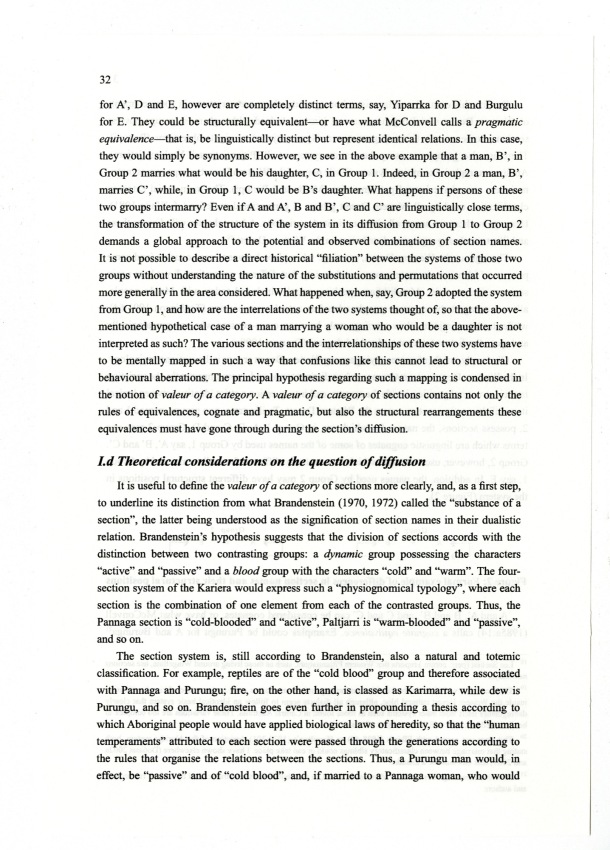|
| 
[Note: this transcription was produced by an automatic OCR engine]
32
for A’, D and E, however are completely distinct terms, say, Yiparrka for D and Burgulu
for E. They could be structurally equivalent—or have what McConvell calls a pragmatic
equivalence—that is, be linguistically distinct but represent identical relations. In this case,
they would simply be synonyms. However, we see in the above example that a man, B’, in
Group 2 marries what would be his daughter, C, in Group 1. Indeed, in Group 2 a man, B’,
marries C’, while, in Group 1, C would be B’s daughter. What happens if persons of these
two groups intermarry? Even if A and A’, B and B’, C and C’ are linguistically close terms,
the transformation of the st:ructure of the system in its diffusion from Group 1 to Group 2
demands a global approach to the potential and observed combinations of section names.
It is not possible to describe a direct historical “filiafion” between the systems of those two
groups without understanding the nature of the substitutions and permutations that occurred
more generally in the area considered. What happened when, say, Group 2 adopted the system
from Group 1, and how are the interrelations of the two systems thought of, so that the above-
mentioned hypothetical case of a man marrying a woman who would be a daughter is not
interpreted as such? The various sections and the interrelationships of these two systems have
to be mentally mapped in such a way that confusions like this cannot lead to structural or
behavioural aberrations. The principal hypothesis regarding such a mapping is condensed in
the notion of valeur of a category. A valeur of a category of sections contains not only the
rules of equivalences, cognate and pragmatic, but also the structural rearrangements these
equivalences must have gone through during the section’s diffusion.
I.d Theoretical considerations on the question of diffusion
It is useful to define the valeur of a category of sections more clearly, and, as a first step,
to underline its distinction from what Brandenstein l970, 1972 called the “substance of a
section”, the latter being understood as the signification of section names in their dualistic
relation. Brandenstein’s hypothesis suggests that the division of sections accords with the
distinction between two contrasting groups: a dynamic group possessing the characters
“active” and “passive” and a blood group with the characters “cold” and “warm”. The four-
section system of the Kariera would express such a “physiognomical typology”, where each
section is the combination of one element from each of the contrasted groups. Thus, the
Pannaga section is “cold-blooded” and “active”, Paltjarri is “warm-blooded” and “passive”,
and so on.
The section system is, still according to Brandenstein, also a natural and totemic
classification. For example, reptiles are of the “cold blood” group and therefore associated
with Pannaga and Pumngu; fire, on the other hand, is classed as Karimarra, while dew is
Purungu, and so on. Brandenstein goes even further in propounding a thesis according to
which Aboriginal people would have applied biological laws of heredity, so that the “human
temperaments” attributed to each section were passed through the generations according to
the rules that organise the relations between the sections. Thus, a Punmgu man would, in
effect, be “passive” and of “cold blood”, and, if married to a Pannaga woman, who wotfld
|